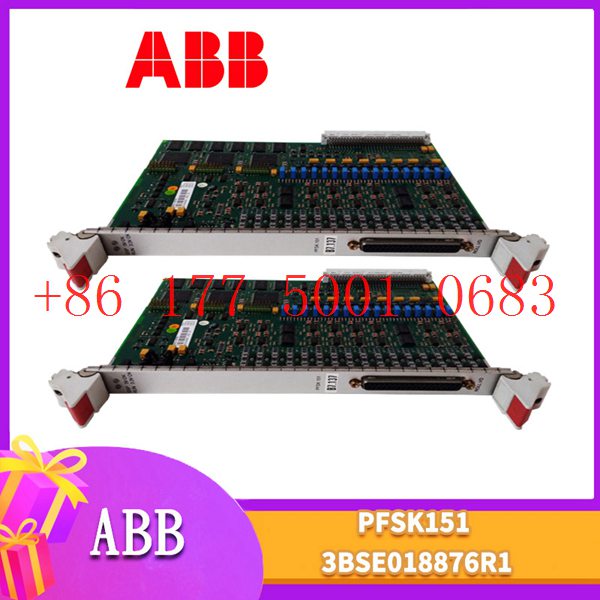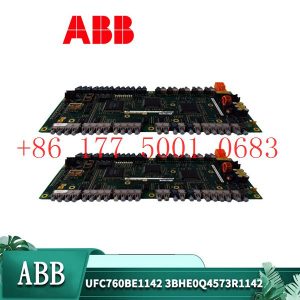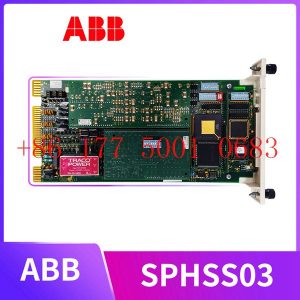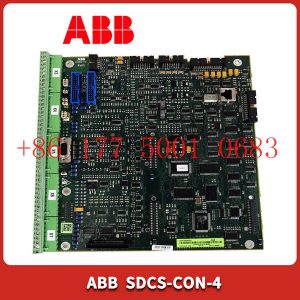Description
hardware flow control. It is an ideal choice in the field of industrial automation.
Implementation of communication between ABC industrial robot and PLC based on DeviceNet fieldbus technology
introduction
In modern production systems, industrial robots and PLCs need to communicate and collaborate to complete production tasks. That is, the
industrial robots output signals to the PLC, allowing the PLC to control related equipment to drive the robot”s front-end tools. This article
mainly analyzes the communication problems between ABB industrial robots and PLC based on DeviceNet fieldbus technology.
DeviceNet is a common network communication method in the field of automation. ABB industrial robots establish a network to communicate with
Siemens PLC based on the DeviceNet network.
1Configure DSQC652
There are mainly 5 types of standard I/0 boards commonly used in ABB industrial robots [2]. Except for the different addresses assigned to
them during setup, their configuration methods are basically the same. This article mainly analyzes the ABB standard I/0 board DS0C652, which
mainly builds communication modules based on the DeviceNet network. The DS0C652 board has a distributed I/O module with 16 digital input and 16
digital output interfaces. The board is installed in the ABB industrial robot control cabinet. First, define the specific operation steps of the DS0C652 board,
enter the teach pendant control panel, then enter the configuration menu (Figure 1), select the DeviceNetDevice menu, and add a template to enter Figure 2.
ABB standard I/0 board is hung on the DeviceNet
network, so the address of the module in the network must be set. The jumpers 6 to 12 of terminal x5 are used to determine the address of the module.
The available address range is 10 to 63. Modify the parameters in the template parameters to complete the DS0C652 board settings. Click the drop-down
menu to select the “Use value from template” row, select
“DS0C65224VDCI/0Device”, and then the parameters that need to be set include the address of the I/0 board in the bus.
Figure 1 Configuring DSQC652
2Configure signals and parameters
After completing the DS0C652 board setting, the I/0 signal setting will be performed. Setting the I/0 signal is the basis for establishing communication with
the PLC. The PLC communicates and transmits data with the ABB industrial robot through the I/0 signal and the DS0C652 board. As shown in Figure 3, in the
signal configuration interface, there are many default I/0 points after the system is established. Modification is not allowed. Click “Add” to add signals. When setting
input and output signals, their address range is 0~15. First, enter the signal menu in the configuration options to set the input and output types, and modify the corresponding parameters.
After completing the settings, the computer prompts that you need to restart the settings. If there are multiple signals that need to be defined and the waiting time
is long after restarting multiple times, you can click “Cancel” and wait for all signals to be defined before clicking the “Yes” button to restart. After the signal settings are
completed, click to select “Input and Output” in the ABB menu to check whether all signals have been set.
Figure 2 Configure DSQC652 parameters
Figure 3 Signal parameter settings
During the signal establishment process, attention should be paid to the DSoC652 port and PLC port addresses used, and the corresponding address table should be
established, as shown in Table 1. The robot interacts with the PLC through I/O signals. During the setting process, there must be no errors in the port and address number
of the PLC connected to the DSoC652. If the address is set incorrectly, the communication between the robot and the PLC will not work properly.
The entire robot teaching pendant setting process is shown in Figure 4.
PFTL101B5.0KN 3BSE004191R1 ABB
3BSE004214R1 Tension sensor ABB
PFTL101BE2.0KN Tension sensor ABB
PFTL101BE2.0KN 3BSE004214R1 ABB
3BSE007913R0010 Tension sensor ABB
PFTL201C10KN Tension sensor ABB
PFTL201C10KN 3BSE007913R0010 ABB
3BSE019050R10001.0KN Tension sensor
PFTL301E Tension sensor ABB
PFTL301E 3BSE019050R10001.0KN ABB
3BSE006503R1 Signal conditioning board
PFSA140 Signal conditioning board ABB
PFSA140 3BSE006503R1 ABB
3BSE002616R1 Signal conditioning board
PFSK130 Signal conditioning board ABB
PFSK130 3BSE002616R1 ABB
3BSE006505R1 Signal conditioning board
PFSK142 Signal conditioning board ABB
PFSK142 3BSE006505R1 ABB
3BSE018876R1Signal conditioning board
PFSK151 Signal conditioning board ABB
PFSK151 3BSE018876R1 ABB
ABB excitation control board 3BSC980006R361
3BSE018877R2 Signal concentrator board
PFSK152 Signal concentrator board ABB
PFSK152 3BSE018877R2 3BSC980006R361
3BSE009514R1 Signal concentrator board
PFSK160A Signal concentrator boardABB
PFSK160A 3BSE009514R1 ABB
3BSE015088R1 Distributedcontrolcard
PFSK162 DistributedcontrolcardABB
PFSK162 3BSE015088R1 ABB
PFSK164 3BSE021180R1 ABB
3BSE021180R1 Distributedcontrol card
PFSK164 Distributed control card ABB
3BHB004661R0001 drive unit ABB
KUC711AE drive unit ABB
3BHB004661R0101 drive unit ABB
KUC711AE101 drive unit ABB
3BHB000652R0001 drive unit ABB
KUC720AE drive unit ABB
3BHB000652R0001 drive unit ABB
3BHB003431R0001 drive unit ABB
KUC720AE01 drive unit ABB
3BHB005243R0105 drive unit ABB
KUC755AE105 drive unit ABB
3BHB005243R0106 drive unit ABB
KUC755AE106 drive unit ABB
3BHE023584R2365 CPU ABB
PPD113-B03-23-111615 CPU ABB
3BHE023784R1023 CPU ABB
PPD113B01-10-150000 CPU ABB
3BHE023584R2634 CPU ABB









Reviews
There are no reviews yet.